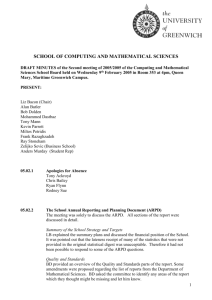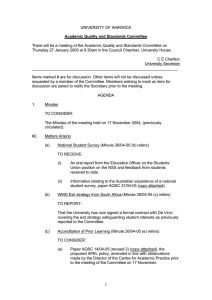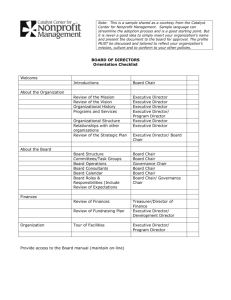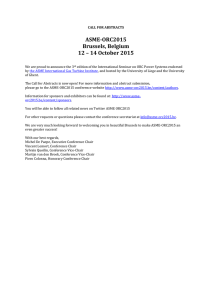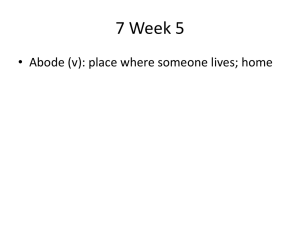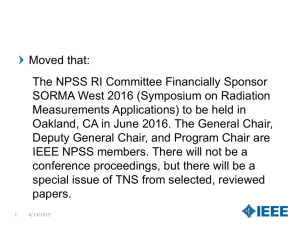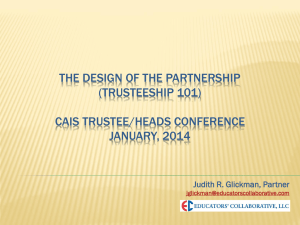8 February 2006 - University of Greenwich
advertisement
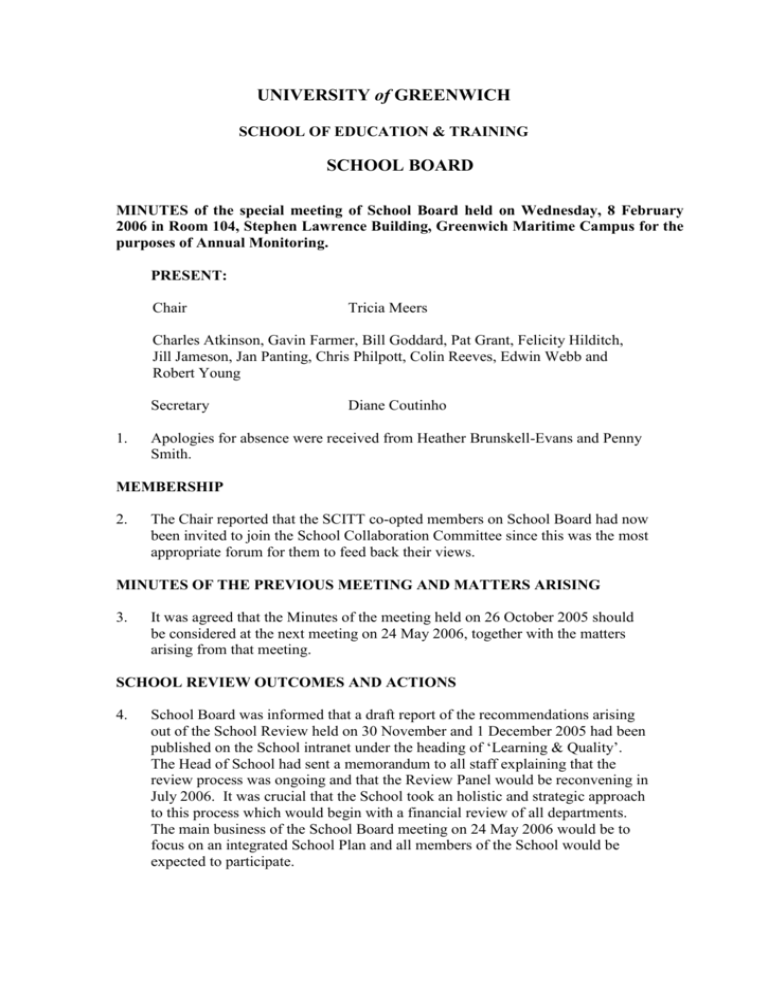
UNIVERSITY of GREENWICH SCHOOL OF EDUCATION & TRAINING SCHOOL BOARD MINUTES of the special meeting of School Board held on Wednesday, 8 February 2006 in Room 104, Stephen Lawrence Building, Greenwich Maritime Campus for the purposes of Annual Monitoring. PRESENT: Chair Tricia Meers Charles Atkinson, Gavin Farmer, Bill Goddard, Pat Grant, Felicity Hilditch, Jill Jameson, Jan Panting, Chris Philpott, Colin Reeves, Edwin Webb and Robert Young Secretary 1. Diane Coutinho Apologies for absence were received from Heather Brunskell-Evans and Penny Smith. MEMBERSHIP 2. The Chair reported that the SCITT co-opted members on School Board had now been invited to join the School Collaboration Committee since this was the most appropriate forum for them to feed back their views. MINUTES OF THE PREVIOUS MEETING AND MATTERS ARISING 3. It was agreed that the Minutes of the meeting held on 26 October 2005 should be considered at the next meeting on 24 May 2006, together with the matters arising from that meeting. SCHOOL REVIEW OUTCOMES AND ACTIONS 4. School Board was informed that a draft report of the recommendations arising out of the School Review held on 30 November and 1 December 2005 had been published on the School intranet under the heading of ‘Learning & Quality’. The Head of School had sent a memorandum to all staff explaining that the review process was ongoing and that the Review Panel would be reconvening in July 2006. It was crucial that the School took an holistic and strategic approach to this process which would begin with a financial review of all departments. The main business of the School Board meeting on 24 May 2006 would be to focus on an integrated School Plan and all members of the School would be expected to participate. ANNUAL REPORTING AND PLANNING DOCUMENT, 2004-5 5. The draft ARPD was currently being compiled by the Chair, with contributions from members of the Senior Management Team. The University had stipulated that this document should be more succinct than previously, with no section exceeding two pages of A4 paper. A six page executive overview would be considered by the Vice Chancellor’s Group. The final version of the document, incorporating the contributions of the School Board working groups (see Minutes 12-14 below) would be circulated to members in due course. Action: Chair/Secretary 6. The ARPD was required to incorporate an analysis of School-level data from the University Statistical Digest for the last three academic sessions. The Digest and a disk containing ‘pivot tables’ had recently been circulated and it was possible to interrogate the data so as to obtain further analyses at departmental and programme level. Members of the Senior Management Team had attended a demonstration on how to ‘drill down’ into the data. Tables containing progression statistics by department and programme had already been produced for consideration by School Board (see Minute 12 below). 7. Looking at the figures, members pointed to apparent discrepancies in certain programmes: for example, the numbers registered to the Doctorate in Education and the Foundation Degrees at partner colleges were lower than the figures held by Programme Leaders. It was important that the data be checked thoroughly by mid-February as the student credit file formed the basis for calculation of the School’s staff:student ratio. The Chair would ascertain whether this referred to the amount of credit studied or was in accordance with the HEFCE formula of credit achieved (ie courses passed) by students. Action: Chair BENCHMARKING AND STRATEGIC PLANNING 8. School Board considered an extract from an Open University publication [‘Managing Institutional Self-Study’ by Watson and Maddison (2005), pages 156-162] entitled ‘Student Retention: a case study’. The case study provided some useful insights into comparing retention rates across the sector for the purposes of benchmarking and strategic planning. The annual Performance Profiles produced by the Training & Development Agency for Schools formed just such a benchmark for initial teacher training in the compulsory sector and the latest figures (2003-04) had been circulated for School Board’s consideration (see Minute 13 below). 9. It was pointed out that, in the Post Compulsory sector, few institutions offered provision on the scale and complexity of our PCET network so it was difficult to make meaningful comparisons. The more flexible approach afforded by our part-time and distance learning programmes was in line with the national agenda to widen participation but tended to lower our published completion and retention rates, under the current reporting schema. The HEFCE model counted all students who did not complete in the normal timeframe (eg deferrals and interruption of study) as ‘fails’. COLLABORATIVE PROVISION 10. The draft Collaborative Provision section of the ARPD was circulated and members were invited to provide feedback before it was finalised. The section would be edited in order to meet the requirements for conciseness but the full version would be retained by the School as a useful document for future planning. WORKING GROUPS 11. School Board members split into three working groups to look at benchmarks, reflection on practice and planning improvement strategies. Each group reported back as set out below. Progression Data 12. This group looked at the statistical tables extracted from the University Digest for the 2002-3, 2003-4 & 2004-5 sessions. On the whole the School of Education & Training compared well with other Schools in the University, particularly in full-time professional programmes. The figures for part-time and flexible learning modes were more problematic because of the difficulty of tracking students’ progress, especially for those who registered in January. The ‘fail’ category was misleading as it appeared to include deferred and fail/repeat students; a more meaningful analysis would be possible if this were broken down into more specific types of non-completer. The ‘unknown’ category would benefit from further investigation. TDA Performance Profiles 13. Having examined the data for the postgraduate Primary Education programme, this group highlighted certain trends which should receive further scrutiny: (i) whilst the ethnic minority intake was 2% higher than the sector average it was 8% lower than that of teacher training institutions based in London; (ii) the number of male students on the programme was below average when compared against both the sector and London institutions; (iii) the age profile was similar to that of other institutions with the majority of students being in the ‘mature’ category (45% between 25-34 and 23% between 35-44) – many of these had childcare needs which could be addressed through the careful timetabling of classes; (iv) the percentage of entrants with a degree class of upper second or above was 22% below the sector average and 13% below the London average so the ‘value added’ by the University should be celebrated; (v) the achievement of Qualified Teacher Status was lower in comparison with both the sector and London institutions (by 6% and 4% respectively) but this included a majority of deferrals rather than fails; (vi) the employment figures compared well nationally (1% above the sector average) but there had been a high return for the ‘not known’ status of 19%. Student Feedback 14. This group focused on the January 2005 National Student Survey conducted with final year students in Education (which did not include teacher training students, except for some on the Post Compulsory programme). In Education Studies the School matched or exceeded the values of two peer group institutions in South East London but obtained lower values than the sector average. Positive feedback in relation to the quality of teaching and support from staff had been received but there were issues to be addressed in terms of assessment, feedback on assignments and the organisation and management of courses. It was important that all departments adhere to School policy regarding the format and time limit for written feedback to students. DATE OF NEXT MEETING 15. Wednesday, 24 May 2006 at 2.15 pm in Room 133, Mansion Building, Avery Hill Campus. This will be a School Board/Whole School meeting to look at an integrated School Plan prior to the School Review event in July 2006.

